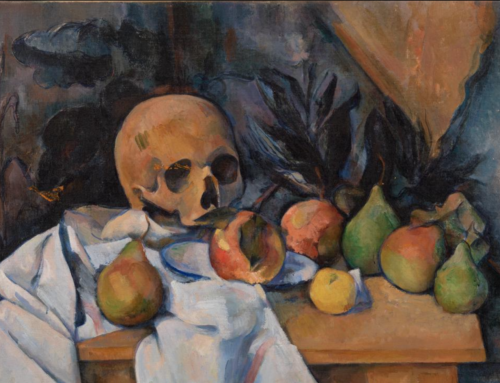In 1922, the year Bronislaw Malinowski’s published Argonauts of the Western Pacific, a film titled The Fundamentals of the Einsteinian Relativity Theory premiered at the Frankfurt Fair. Probably the first ever science film, it was designed to bring Albert Einstein’s theory of relativity to the general public. We might say that the book and the film—just like these two scholars of the culturally and scientifically relative—were “contemporaries.” In other words, they shared a present. We might say that, though the very content of Einstein’s theory may give us pause.
Before Einstein discovered the knitted nature of spacetime, the present was sandwiched neatly between the past and the future: an undifferentiated and collectively shared experience of the here and now. But this, Einstein told us, was fiction. The present, as the physicist Carlo Rovelli explains, “is like the flatness of the Earth: an illusion” (2017, 59).
What are the implications for anthropology of this illusory present?

Lahore, Pakistan. Photo by Timothy P.A. Cooper.
Einstein discovered that there exists, in Rovelli’s words, an “intermediate zone”: a space between the past and the future whose duration is relative based on distance from an event. At short distances, this zone is imperceptible to human perception, a mere nanosecond. But as the distance grows—the distance between London and Frankfurt, say, or London and the Trobriand Islands—the interval expands. Between Earth and Mars this interval is as long as a quarter of an hour. The present as a shared experience across the universe is “an effect of our blindness: our inability to recognize small temporal intervals. It is an illegitimate extrapolation from our parochial existence” (Rovelli 2017, 59).
For a discipline so avowedly opposed to parochialism, Einstein’s ideas seemed to have had little impact on early anthropologists, whose ethnographies tended to suspend peoples in a present outside of time entirely. “The social anthropologist normally studies the population of a particular place at a particular point in time,” wrote Edmund Leach, with his teacher Malinowski firmly in his sights. “In the result we get studies of Trobriand society, Tikopia society, Nuer society, not ‘Trobriand society in 1914,’ ‘Tikopia society in 1929,’ ‘Nuer society in 1935,. … the authors write as if the Trobrianders, the Tikopia, the Nuer are as they are, now and forever” (1964, 7).
Such critiques are well known. We grappled with the problem of the “ethnographic present” decades ago. And you would be hard pressed, today, to find any anthropologist whose writing denies a coevalness with the people they study, in the manner that Johannes Fabian so influentially critiqued. What’s more, even as our methodological conventions continue to position the present as anthropology’s hallmark temporal domain—our “thick temporal middle” (Robbins 2015, 217)—we increasingly venture beyond it: joining interlocutors in their labours in/of time (Bear 2014); backwards through archives of history, memory, and genealogy; and forwards along trajectories of aspiration, hope, and speculation.
As ethnographers of haunting pasts and increasingly menacing futures, what have we done—what are we to do—with that illusion of the present?
This collection of essays asks what happens when the present becomes an object of direct reflection and contention, in anthropology and in ethnographic worlds. The present comes into view not just as a moment fractured or unsettled by deepening crisis and worsening inequality, or as a mood buoyed by momentary pleasure. Insights also emerge into how people everywhere are shaping, severing, and stitching together their presents, alongside lessons for how anthropologists may be present to these practices in the here and now. Such presents might carry utopian (or dystopian) potentials, tracing blueprints of a world not quite here (Muñoz 2009).
Two things seem true. Our methods, still grounded in some version of “being there,” offer a uniquely powerful way to arrive at a common present that (unhindered to the greatest extent possible by the infinite relativity of temporal intervals) is shared by those who read us and those we write about. At the same time, because anthropology sits somewhere between the positivistic sciences and the interpretive arts, we are forced to think about what, empirically, counts as the present. Unlike colleagues in other disciplines, we must directly contend with the fragility of any spacetime shared with the subjects of our study: the way that it crumbles as we exit our field sites, recedes as we start to write, and all this notwithstanding the tethers of digital connection.
In light of this, it need not be tautological to speak of an anthropology of the present. Nor should we take for granted anthropology’s presentist orientation. Usually a pejorative term, historians label “presentist” those colleagues who approach past periods through the frames of today. The critique is that historical sources should be understood on their own terms, as if it is possible to bypass the scholarly conduit to savour an unmediated connection between humans across times. Beyond the historian’s critique, presentism can take different forms, as Richard Irvine (2020, 80) explains: the metaphysical assertion that the present is all that exists; the sociological claim that immediacy is valorized over longer-term thinking; the analytical mode that takes the present to be the preeminent abstraction in any analysis of temporally interacting elements.
For our purposes, consider the framing of the three American Anthropological Association (AAA) conferences immediately preceding the COVID-19 pandemic. Each was organized around the idea that the potential public good of anthropology could be realized—in the here and now—via urgent societal, ecological, and political action: “Changing Climates” (2019); “Resistance, Resilience, Adaption” (2018); “Anthropology Matters!” (2017). To be sure, many anthropologists have long had such ambitions, as part of a tradition of public-facing scholarship shared with the makers of the 1922 Einstein film. But perhaps, as the earth enters a new geological epoch defined by human impact, anthropology sees itself also entering a new era, becoming a kind of disciplinary loudspeaker for urgent political demands, widening the bottlenecks of policy streams and funding cycles. The historian’s critique is reversed. Urgency, crisis, impact: nothing is more pressing than the present.
Or at least that is the demand, more or less explicitly made. It isn’t our intention to contest it here. What follows, rather, are exercises in thinking through some of the assumptions and implications of this presentist push and pull. Such exercises do not take place in a vacuum. “Discussions about the contours and contents of the shared historical present are … always profoundly political ones,” as Lauren Berlant writes. “We understand nothing about impasses of the political without having an account of the production of the present” (2011: 4).
For starters, what do we, as anthropologists, actually mean when we talk about “the present”?
In 2024, as in 1922, we may think we know. But by following how people approach the present—as a point of departure, zone of activity, or site of arrival—the authors in this collection of articles point to its many overlooked problems, paradoxes, and possibilities: how Japanese disaster preparation works to keep the prospect of disaster alive in people’s everyday awareness; how struggles over the ancient underground waters of Jerusalem articulate the present tense; how Burmese revolutionaries today imbue their struggles with the politics of past insurgencies; and how Jamaican kumina ritual orients us to conceptions of the present—and practices of presence—less bounded and more relational than the dominant Euro-American notions of time and personhood allow.
This last point is key. It raises one of the questions that drives this collection—one that often rests unspoken beneath much writing on anthropology’s methods and motivations. It is an idiosyncrasy of English that “the present” and “presence” are etymologically and semantically linked. In Urdu, to give one counter example, the word for “the present”—haal—emanates from an Arabic root that also offers terms for moods, attitudes, and processes of transformation. In spaces of Islamic mysticism, haal can describe states of ecstasy achieved in the pursuit of love or divinity.
What happens if, led by our interlocutors, and inspired by such different connotative possibilities, we were to think anew about the relationship between “the present” and “presence”? How might that also transform how we think about urgency, immediacy, contemporaneity, solidarity, and the prospects for new forms of anthropological witnessing (Chua 2021)?
The implications run far and deep. As the late philosopher Gillian Rose put it, “to be present to each other, both at the point of difficult ecstasy and at the point of abyssal infinity, brings you into the shared cares of the finite world” (1995, 71). If our current moment (such as it is) requires an anthropology that is as reparative as it is liberatory (Cox 2022), what are the possibilities for anthropological care in, about, and for the present?
References
Bear, Laura. 2014. “Doubt, conflict, mediation: the anthropology of modern time”, Journal of the Royal Anthropological Institute 20 (S1): 3-30
Berlant, Lauren. 2011. Cruel Optimism. Durham, NC: Duke University Press.
Cox, Aimee Meredith. 2022. “Worldmaking and the ethnographic possibilities for an abolitionist anthropology”, Cultural Dynamics 34 (1-2): 100-105.
Irvine, Richard. 2020. An Anthropology of Deep Time: Geological Temporality and Social Life. Cambridge: Cambridge University Press.
Muñoz, José Esteban. 2009. Cruising Utopia: The Then and There of Queer Futurity. New York: NYU Press.
Leach, Edmund. 1964 [1954]. Political Systems of Highland Burma. Boston: Beacon Press.
Robbins, Joel. 2015. “On happiness, values, and time: the long and the short of it”, HAU: Journal of Ethnographic Theory 5 (3): 215-233.
Rose, Gillian. 2011. Love’s Work. New York: NYRB Classics.
Rovelli, Carlo. 2017. Reality Is Not What It Seems: The Journey to Quantum Gravity. Translated by Erica Segre and Simon Carnell. London: Penguin Press.
Timothy P.A. Cooper is an anthropologist studying religion, ethics, and comparative media in contemporary Pakistan. Currently a Leverhulme Trust Early Career Fellow at the Department of Social Anthropology at the University of Cambridge, his first book, Moral Atmospheres: Islam and Media in a Pakistani Marketplace is out with Columbia University Press in 2024 and was awarded the Claremont Prize in the Study of Religion.
Michael Edwards is a Lecturer in Anthropology at the University of Sydney whose research focuses on religious life, media ecology, and political change. His first book project, Real Change: Myanmar and the Dissonance of Salvation, has been selected for the Atelier series at the University of California Press.
Nikita Simpson is a Lecturer in Anthropology at SOAS, University of London, and a Visiting Research Associate at the Sydney University Policy Lab. Her research focuses on mental health, care and inequality in India, Australia and the UK and has been published in the BMJ Global Health, JRAI and MAQ amongst other venues. Her first book project, titled Tension: Mental Distress and Modern Time in the Western Himalayas is forthcoming.
Cite As: Cooper, Timothy P.A., Edwards, Michael & Simpson, Nikita. 2024. “Introduction: Back/s to the Present”, In “Back to the Present” edited by Timothy P.A. Cooper, Michael Edwards & Nikita Simpson, American Ethnologist website, January 26 2024, [https://americanethnologist.org/online-content/collections/back-to-the-present/back-to-the-present-1/]




